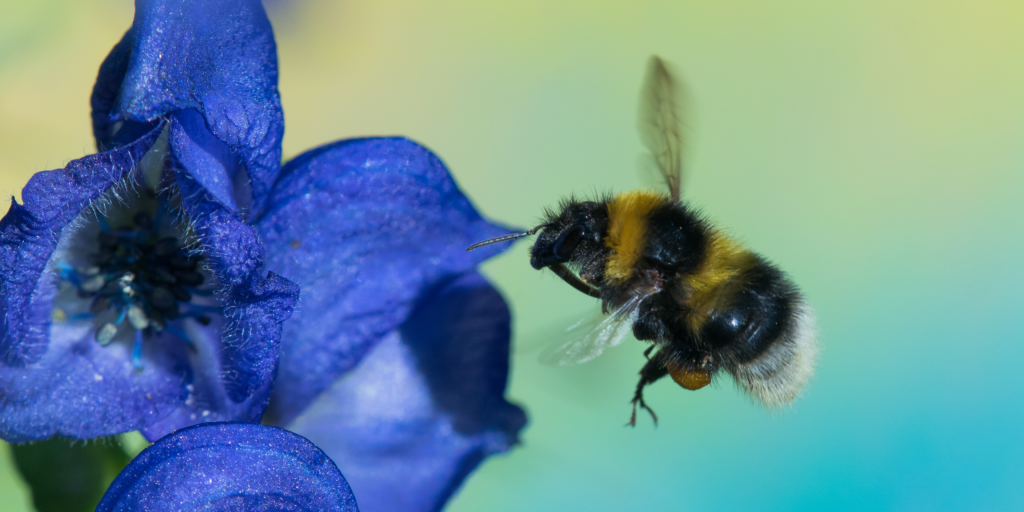

We Have A Podcast Episode On This Subject!
Want to learn about this topic in a different format? Check out our episode of The Open Sanctuary Podcast all about being kind to bees at animal sanctuaries!
While you may have an established sanctuary where you care for chickens, goats, horses, rabbits, or whomever else, there is another group you can help: bees. By now, you have likely heard the concerns of bee species becoming extinct, and while they are vital to our ecosystems and our overall survival, they are also worth saving because they too deserve a life free from harmThe infliction of mental, emotional, and/or physical pain, suffering, or loss. Harm can occur intentionally or unintentionally and directly or indirectly. Someone can intentionally cause direct harm (e.g., punitively cutting a sheep's skin while shearing them) or unintentionally cause direct harm (e.g., your hand slips while shearing a sheep, causing an accidental wound on their skin). Likewise, someone can intentionally cause indirect harm (e.g., selling socks made from a sanctuary resident's wool and encouraging folks who purchase them to buy more products made from the wool of farmed sheep) or unintentionally cause indirect harm (e.g., selling socks made from a sanctuary resident's wool, which inadvertently perpetuates the idea that it is ok to commodify sheep for their wool).. Each individual, fuzzy-bummed or not, is important. And the great thing is that you can take steps to make your sanctuary more bee-friendly by providing the right space and resources for native bees in your area!
The Honeybee Misconception
You may have heard a lot of “save the bees!” in the media over the past few years. However, when we hear about the extinction of bees, we hear most talk about honeybees. Contrary to what you may have heard, honeybees are not in danger of extinction. Honeybees are domesticatedAdapted over time (as by selective breeding) from a wild or natural state to life in close association with and to the benefit of humans, farmed across the world, and receive a lot of attention from humans as many have a monetary stake in their continued existence. This may surprise you, but honeybees do not contribute to the majority of pollination. Native bee species (and other pollinators) take care of the majority of this. Many species evolved to be built just right to efficiently pollinate certain types of fruits or flowers. There are many fruits and other plants that honeybees simply aren’t up to the task of pollinating. This isn’t to say that honeybee populations (and individuals) don’t contribute to pollination and aren’t negatively impacted by human behavior, just that they don’t pollinate nearly as much as others and aren’t likely to go extinct like many other species are.
In terms of extinction, it’s the other bees we have to worry about, many of which you have likely never even heard of! Solitary bees, species of bumblebees, mason bees, and others are in danger, their populations are greatly affected by pesticide use, land ack of habitats, food, and resources. So when you see “save the bees,” think native bees.
The Buzz On Bees
There are thousands of species of bees! You may not even be aware of the different types of bee species in your area. While you might be most familiar with bees that have hives, many bees actually nest underground! Let’s look at a few types of bees just to familiarize you with the different needs bees may have, and then we will discuss tips to help them find a home and resources at your sanctuary!
Some bees nest in crevices or small, empty spaces and holes. Others are called architects who build individual structures from plant fibers and resin, and others still who build hives. Many bees actually make their homes underground. Some even make homes by chewing through wood and creating homes there. They can make amazingly round holes and tunnels in wood this way!
What does this mean for sanctuaries who want to help our bee friends in the area? First off, there are some general things you can do that will help any species of bee. Let’s take a look:
Tip 1: Do Nothing!
Well, not “nothing,” but by leaving green spaces alone for a time, especially those with “weeds,” you might help provide food for bees. Dandelion, clover, thistles, chickweed, ragwort, henbit, docks, dead nettle, and speedwell are all delicious fare for bees. Depending on where you live, the “weeds” in question might differ from those listed here. Do a little digging and learn about bee favorites in your area. And don’t be hasty to mow at the first sign of weed blossoms!
Keeping working areas and areas around resident living spaces clear is important to help discourage mice, snakes, or other small wildlife from entering resident living areas. But leaving some other areas for bees can be a big help to them. And if you are worried about aesthetics, you can put up a sign that reads something like, “Excuse the mess! We are feeding the Bees!” This can be a simple and fun way to explain why you haven’t mowed the area and educate others at the same time!
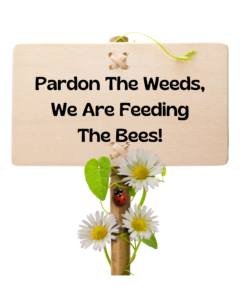
Tip 2: Plant Native Flowers And Trees
In addition to leaving the weeds alone for a time, consider planting native flowers and trees at your sanctuary. Planting in plots of at least 3×3 square feet can create an attractive buffet for bees as they will be most drawn to areas with lots of flowers. If you are going to plant native flowers and trees, be sure to plant enough species of flowers that will provide bees food throughout the season. Flowers and trees can be broken down into early, mid, and late seasons, although you may live in areas without such a breakdown in seasons, and you have temperate weather year-round. For those who live in the United States, you can find a guide to native flowers for pollinators in your region here.
Did you know that the favorite color of the buff-tailed bumblebee is violet? Different species of bees are often attracted to different shapes and sizes of flowers because of the size and length of their tongue! If buying plants, be sure to opt for organic if possible, as those grown with pesticides can harm bees.
Tip 3: Cut Out The Chemicals
Speaking of pesticides, be sure to use only bee-friendly organic solutions when growing your green spaces for bees. Fertilizers, herbicides, fungicides, and neonicotinoids (insecticides) can wreak havoc on bees. If you want to go further for bees in your area, see if there are any local or regional legislative efforts to ban harmful chemicals that negatively impact your local bee population and support them!
Tip 4: Splish Splash, Bees Need A Bath
Well, maybe not a bath to bathe in, but bees do need water. Creating a hospitable habitat for bees in your area requires them to have a water source. All that hard work they do collecting pollen and buzzing about can really wear a bee out. Like other species, bees need a place to get a refreshing drink. You can provide this by simply maintaining a birdbath filled with fresh water. You should fill the bath with stones that break the surface tension and give bee neighbors a landing pad for their water breaks.


Tip 5: Educate The Community
Another way you could help bees is by finding easy ways to educate your supporters and community. This might look like sharing the occasional social media post about how to help bees via your social media page or hosting a BeeBlitz event where you download a citizen science app, take pictures of bees, and record your observations. The data collected can help bee scientists learn more about the diversity of bee species in your area! If you provide tours at your sanctuary, consider stopping at a bee area on your tour, be it a habitat you’ve created or simply left alone or an educational corner or poster dedicated to bees. If you provide other types of onsite education programs, particularly for kids, check out our Late Elementary-Age Sanctuary Education Lesson Plan #3, which incorporates pollinator gardening as a tool to teach participants about pollinator animals (like bees!) that are native to your sanctuary’s local area and their importance to your local and global communities.
Tip 6: Provide Nesting Spots And Materials
You can do the bees in your area a favor by providing them with materials to build their nests, or you could even provide them with nesting sites! As mentioned before, there are different types of bees, and these bees don’t all nest the same way. Nesting styles can affect what materials or housing you might provide, depending on the bees present in your area. We often picture a whole colony of honeybees in large hives when we think of bees. However, many bees are solitary bees. This means that many single female bees each build their own nests. Housing for these bees may look like single bees nesting in a sort of community, but each caring for their own nest or they may be a bit more communal with bees sharing a space or the task of providing food for the young. Let’s look at some nesting styles and how you can provide space or materials for those types of nesters:
Ground Nesters
Did you know that most bee species actually live underground? That means these bees need safe areas of land with the right type of soil to make homes.
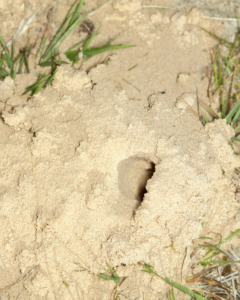
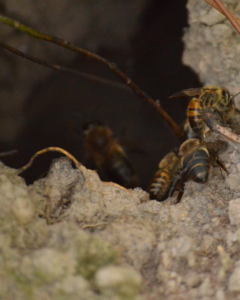
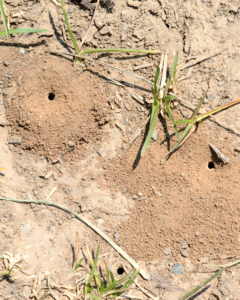
To help ground-nesting bees:
- Leave the leaves! If you experience four seasons in your area, let the leaves that fall in autumn stay there until spring. This helps protect underground nests.
- Provide untouched spaces. Leave areas of land that aren’t highly landscaped to allow safe patches of soil for ground-nesting bees.
- While you must take care not to provide too many spaces for wildlife to take up residence near resident living spaces, providing a small brush or rock pile can help provide cover for ground nesters.
- If you are adding a pollinator garden or just doing a little landscaping, consider planting native bunchgrasses or sedges that grow in clumps. These naturally provide soil space that can be used for bees looking for a good place to nest.
- Avoid heavy, color-treated mulches. Instead, opt for lighter mulches or even lighter layers that allow bees to access the soil underneath.
Wood And Pith Nesters
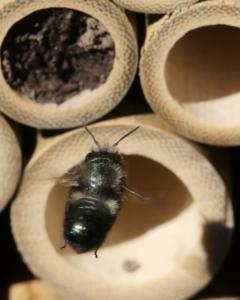
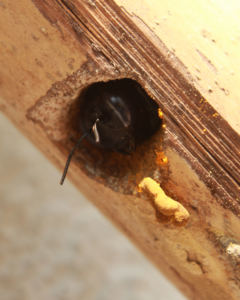
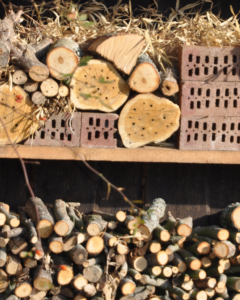
You may have noticed strange, perfectly round holes in seemingly random pieces of wood or in thick, reed-like plants. These could be the nests of wood or pith nesting bees! One of the more well-known wood nesters is the carpenter bee. It’s a fitting name! Wood or pith nesters use their mandibles to eat away tunnels in wood for nests, although they will also nest in available cavities that meet their nesting needs and don’t require the work of chewing an initial hole. If you see carpenter bees or another wood or pith nester species, you may have concerns about them burrowing into resident living spaceThe indoor or outdoor area where an animal resident lives, eats, and rests. structures. To prevent this, you can check that any little crevices are unoccupied and use a resident (and bee)-safe sealant or paint on exposed wood. But that doesn’t mean you can’t help them with a more appropriate home!
To help wood and pith nesting bees:
- Leave dead trees (so long as they don’t pose a safety hazard) on the property.
- Acquire an old log or stump and put it out on the property, perhaps at some choice pollination sites.
- Grow plants like raspberries, joe pye weeds, yucca, agave, hydrangea, thistles, rose, or elderberry, as these can be used by the bees to make their homes. Bigger bee species will need bigger stems, while smaller bees may prefer smaller stems in which to make their homes.
- Leave stalks and seed heads of pithy plants, like the above, over winter. In the spring, cut back but don’t destroy the stems of the plants so bees can access the tubes more easily.
- Build bee motels out of reeds, bamboo, or plant stems from the above. Bundle them together, plug one end, and hang them in a protected space where they receive morning sun but protection from too much heat during the rest of the day if you live in an area with extreme heat. Remove and replace them every winter to prevent mites or fungus from making them unsafe homes for bees. While you can buy bee houses, some of the materials used may actually hurt bees, so take care and buy a bee-safe one!
Cavity Nesters
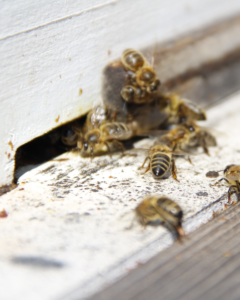
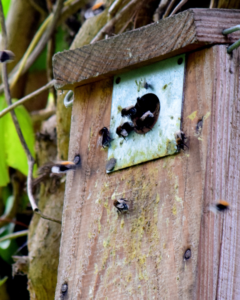
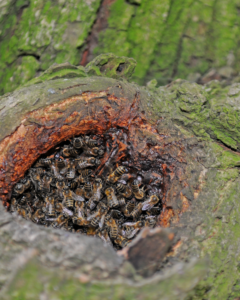
While some wood and pith nesters or ground nesters might happily take up residence in an old mouse burrow or a group of empty stems, other bees seek out different types of cavities, such as those in the crevices or hollows of a tree, in the corner of an awning of a building, or a crack in a wall. Helping cavity nesters can include some of what we mentioned above, so some of this may sound familiar:
- Let dead trees “bee!” A dead tree often has great crevices for cavity-nesting neighbors if they don’t pose a safety risk to residents or humans on-site.
- If you don’t have many trees, dead or otherwise, consider planting more or bringing in large logs and stumps with nice hollows or crevices for nesting.
- Seal crevices in resident living areas to avoid conflict with bee neighbors.
We hope this resource inspires you to help the bee friends in your community. Get buzzy! If you have a bee-friendly sanctuary or have some tips to share, we would love to hear from you! For easier-to-share tips, check out our accompanying infographic.
SOURCES:
You’re Worrying About the Wrong Bees | Wired (Non-Compassionate Source)
The Truth About Honey Bees | The National Wildlife Federation (Non-Compassionate Source)
The Problem With Honey Bees | Scientific America (Non-Compassionate Source)
Pollinator-Friendly Native Plant Lists | Xerces Society For Invertebrate Conservation
How Bees See And Why It Matters | Bee Culture
Bees Seem To Benefit From Having Favorite Colors | Science Daily
Ten Ways To Save The Bees | The Bee Conservancy (Non-Compassionate Source)
5 Ways To Increase Nesting Habitat For Native Bees | Xerces Society For Invertebrate Conservation
Protecting and Providing Nesting for Native Bees and Wasps | Ecological Landscape Alliance








